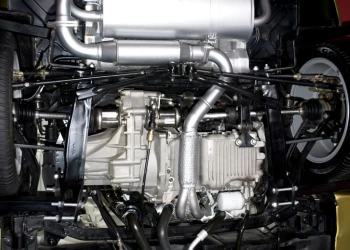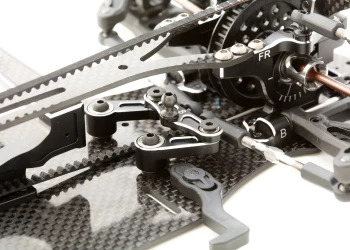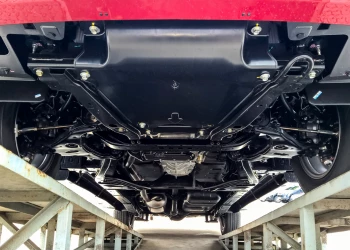Steering systems face stiff challenges along the road to automation
Add bookmarkIn 1988 the motoring world hailed a new era in steering systems when Suzuki unveiled the Electric Power Steering (EPS) on the Cervo: In 2018 General Motors brazenly announced that by 2019 it will do away with the steering wheel completely when it releases the Level 5 Chevy Bolt - sans steering wheel and pedals!
Image source: The Verge
Speaking on the sidelines of CES 2018, GM President Dan Ammann told the Verge: “It’s a pretty exciting moment in the history of the path to wide scale autonomous vehicle deployment and also having the first production car with no driver controls.”
While this was widely hailed as a bold declaration for the future of driving from one of the country’s ‘Big Three’ automakers, Dearborn rivals Ford, were already granted a patent for a car with a fully removable steering wheel and foot pedals in 2017.
Unlike GM, Ford’s design offers the steering as a customer-requested option, as illustrated in the official patent application:
Image Source: US Patent Office
Both company’s designs are aimed at highly automated Level 4/5 vehicles (as defined by SAE J3016), but before these systems can be rolled out in high-volume series production there are several functional, system and component related challenges that have to be addressed.
Smart steering systems demand intelligent engineering solutions
For instance, in L3 driving it’s critical that drivers remain alert and engaged with the environment around them – which is easier said than done. On average it takes a driver about 3 seconds to re-engage with the vehicle in case of an emergency. Therefore manufacturers are challenged to both ensure drivers remain alert, and in case of a crisis, can retake control of the steering without delay.
One solution to determine driver alertness and driving-mode, proposed by Tier one supplier ZF, features a wide range of functions cleverly integrated into the steering wheel: 10 capacitive sensors in the outside rim determine the position of the driver’s hands on the wheel, with an additional sensor on the inside of the rim detecting if an advisable grip is being employed. This enables accurate hands on/off detection, helping to determine whether the driver or the vehicle is in control.
But what happens if a system fails and the driver has to retake control in an emergency: Steering and driveline manufacturer, Nexteer’s, ‘Steering on Demand’ enables the safe, intuitive transition of steering control from manual to automated driving with the press of a button or, when re-taking control, simply by grabbing the steering wheel.
However in a world in transition the vehicle may be a L5 self-driving vehicle with no controls for passengers to take control of in an emergency: In such a case it is vital that a backup or redundant system seamlessly takes over control to either bring the vehicle to a safe stop, or continue in a safe ‘limp-home’ mode.
One such system developed by Bosch, a leading global supplier of technology and services, enhances the EPS system with a “fail-operational function”, which enables either a driver or auto pilot system to make a safe stop in the event of an electrical failure.
The fail-operational function ensures that, should the primary system fail, the fail-safe mode will still provide 50 percent electric steering support via an electrical backup system. This functionality is made possible through a fully-redundant electric/ electronic architecture where a backup actuator takes control should a fault occur with the primary actuator.
The system is able to detect a failure in the steering system and automatically switch to the electrical backup, allowing the driver, if there is one in the loop, to safely steer the vehicle without the sudden increase in steering effort usually assosciated with an EPS failure. With the system designed for highly automated driving, a failure of the EPS with the fail-operational function could also automatically steer the vehicle to a safe stop without bringing the driver back into the loop.
This high level of redundancy enables OEMs to comply with the backup strategies as proposed in the Federal Automated Vehicles Policy documents from the U.S. Department of Transportation (DOT) and National Traffic Highway Safety Association (NHTSA).
Moreover, striving for “best in Class” Bosch has designed the system in a highly integrated format that leads to a cost effective solution for OEMs. Start of production for the EPS with fail-operational function as a scalable modular kit is planned for 2020.
However, with the rapid deployment of higher levels of automation, manufacturers also face major challenges in testing steering systems, under all use cases, to ensure safe and reliable operation in all real-world conditions. Thus manufacturers need to carry out extensive road-testing on public roads.
The challenges of real-world testing
This is well illustrated by GM’s test program, which includes the bustling city of San Francisco. While GM, like Waymo, also conducts testing in Phoenix, San Francisco with an average of 32 times as many possible interactions as those in Phoenix, offers a more complex environment. Thus, San Francisco is a greater challenge to the automated system because, as the number of exchanges increase the number of possible interactions with objects increases exponentially.
A good example of this is the number of contacts with emergency vehicles: The self-driving Chevy Bolts come across 270 emergency vehicles for every 1,000 miles driven in San Francisco, compared to just six in Phoenix.
The results gained from these on-road tests are invaluable and as a result GM would like to increase the size of its test fleet - which poses another challenge:
Because automated vehicles do not strictly comply with the NHTSA’s federal motor vehicle safety standards the manufacturer has to apply for exemption, with the agency only granting 2,500 per year - although this is likely to change with the introduction of the Self Drive Act, where exemptions would start at 25,000 vehicles per manufacturer in the first year, 50,000 vehicles in year two and 100,000 vehicles each in years three and four.
The current restriction, however, requires GM to submit a petition to the NHTSA for permission to deploy cars that don’t fully comply with the safety standards, proposing instead to “meet the requirements in a different way.”
For instance: A car without a steering wheel won’t have a steering wheel airbag, but this can be resolved by fitting an equivalent of the passenger side airbag on the driver’s side as well. Thus the petition seeks to get approval to meet the standards with a different solution to what’s prescribed.
Furthermore, GM’s Ammann believes that by integrating the self-driving system into the vehicle from the beginning, and through close coordination between the hardware and software teams, all the potential critical failure modes have been evaluated and addressed to ensure a safe and reliable product.
This comprehensive, integrated approach to safety, combined with testing in one of the most complex environments in the world, allows the company to safely take the next step - elimination of the steering wheel, pedals and other manual controls -from the vehicle.
But while there’s little doubt automation will change the world, including how steering systems are engineered, tested and function, manufacturers face daunting challenges in safely deploying the technology with the minimum of delay.
Sources
- Andrew J. Hawkins; The Verge; GM will make an autonomous car without steering wheel or pedals by 2019; January 2018; https://www.theverge.com/2018/1/12/16880978/gm-autonomous-car-2019-detroit-auto-show-2018
- General Motors; 2018 Self-Driving Safety Report; January 2018; https://www.gm.com/content/dam/gm/en_us/english/selfdriving/gmsafetyreport.pdf
- Press release; Nexteer Automotive; Nexteer Unveils First Comprehensive Suite of Steering Technology for Autonomous & Mixed Mode Driving; January 2018; https://www.nexteer.com/release/nexteer-unveils-first-comprehensive-suite-of-steering-technology-for-autonomous-mixed-mode-driving/
- Matthew Field; The Telegraph – Technology; Ford to ditch steering wheels in driverless cars of the future; August 2017; http://www.telegraph.co.uk/technology/2017/08/17/ford-patents-removable-steering-wheel-driverless-cars/
- Bosch North America; Electric power steering system from Bosch offers a fail-operational function for a new level of safety; January 2017; http://us.bosch-press.com/tbwebdb/bosch-usa/en-US/PressText.cfm?CFID=60297084&CFTOKEN=9495b733f2ba0eb8-9F193F7C-ECF9-02FE-9D2C4F9E652415A3&nh=00&Search=0&id=775





















